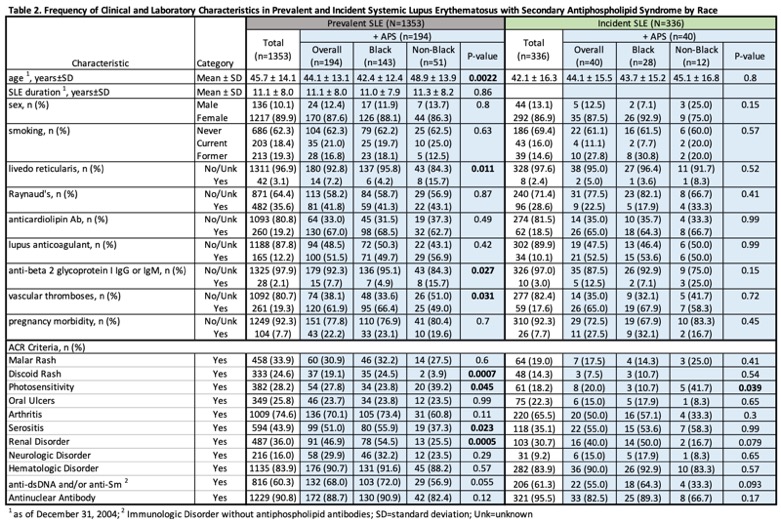Session Information
Session Type: Poster Session A
Session Time: 8:30AM-10:30AM
Background/Purpose: Although APS was originally described in those with SLE, the epidemiology and clinical characteristics of secondary APS (2APS) has not been well described in SLE populations with large numbers of Blacks.
Methods: The Georgia Lupus Registry is a Centers for Disease Control and Prevention-funded population-based registry of validated SLE patients in Atlanta and was designed to determine SLE prevalence in 2002 and incidence in 2002–04. Diagnoses were validated through medical record and database review without the requirement of patient consent. Case definitions included those with ≥4 ACR criteria or 3 ACR criteria with a final diagnosis of SLE by a board-certified rheumatologist. Case finding efforts included searching for APS-related elements from medical records and labs. Validated prevalent and incident SLE cases were matched with the state Hospital Discharge Database from 2002–13, which captured all hospital admissions along with associated diagnoses and procedure codes. 2APS was defined by 1) the treating rheumatologist diagnosis and/or 2) ≥1 clinical and ≥1 laboratory criteria after SLE diagnosis using a modified Sydney classification criteria. Clinical criteria included vascular thromboses and pregnancy morbidity captured by medical record review and/or hospital diagnosis codes. Laboratory criteria for anticardiolipin (aCL), lupus anticoagulant (LA), and/or anti-b2 glycoprotein-I IgG or IgM (ab2) were captured by medical record and laboratory review. Frequency of clinical and laboratory characteristics were reported for prevalent and incident SLE cases overall and compared between SLE cases with (+APS) and without 2APS (-APS) and between Black and non-Black SLE cases +APS.
Results: In prevalent SLE, 14.3% (194/1353) had 2APS with no differences in age, SLE duration, or sex between APS status [Table 1]. In +APS, there were 67% aCL, 51.5% LA, and 7.7% ab2 (-APS: 11.2, 5.6, and 1.1%, respectively) with 61.9% vascular thromboses and 22.2% pregnancy morbidity. Anti-dsDNA and/or Sm, livedo reticularis, serositis, renal, neurologic, and hematologic disorder were also more frequent. In incident SLE, 11.9% (40/336) had 2APS with no differences in age, SLE duration, or sex between APS status. In +APS, there were 65% aCL, 52.5% LA, and 12.5% ab2 (-APS: 12.2, 4.4, and 1.7%, respectively) with 65% vascular thromboses and 27.5% pregnancy morbidity. There was also more smoking, arthritis, serositis, and ANA positivity. Blacks with prevalent SLE had 2APS less frequently than non-Blacks (143/1024 or 14.0% vs 51/329 or 15.5%) and were younger and had more vascular thromboses, discoid, serositis, and renal disorder but less livedo, ab2, and photosensitivity compared to non-Blacks [Table 2]. Blacks with incident SLE had 2APS less frequently than non-Blacks (28/247 or 11.3% vs. 12/89 or 13.5%) and had less photosensitivity.
Conclusion: The burden of 2APS in SLE in this population-based study ranged from 11.9 to 14.3%. There were notable differences in prevalent and incident SLE by APS status and by race, which may provide insight into the pathophysiology of 2APS. Further research is needed into this important subgroup.
To cite this abstract in AMA style:
al-naqeeb J, Bao G, Drenkard C, Lim S. Frequency and Clinical Characteristics of Secondary Antiphospholipid Syndrome in Systemic Lupus Erythematosus: The Georgia Lupus Registry [abstract]. Arthritis Rheumatol. 2021; 73 (suppl 9). https://acrabstracts.org/abstract/frequency-and-clinical-characteristics-of-secondary-antiphospholipid-syndrome-in-systemic-lupus-erythematosus-the-georgia-lupus-registry/. Accessed .« Back to ACR Convergence 2021
ACR Meeting Abstracts - https://acrabstracts.org/abstract/frequency-and-clinical-characteristics-of-secondary-antiphospholipid-syndrome-in-systemic-lupus-erythematosus-the-georgia-lupus-registry/


